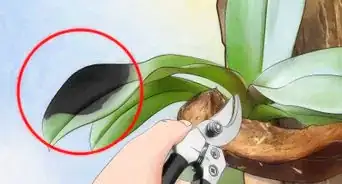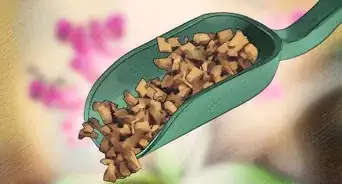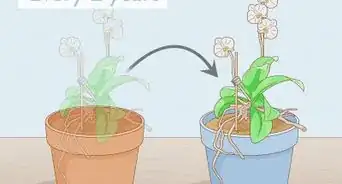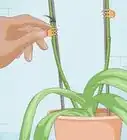This article was co-authored by Lauren Kurtz and by wikiHow staff writer, Sophia Latorre. Lauren Kurtz is a Naturalist and Horticultural Specialist. Lauren has worked for Aurora, Colorado managing the Water-Wise Garden at Aurora Municipal Center for the Water Conservation Department. She earned a BA in Environmental and Sustainability Studies from Western Michigan University in 2014.
wikiHow marks an article as reader-approved once it receives enough positive feedback. In this case, 94% of readers who voted found the article helpful, earning it our reader-approved status.
This article has been viewed 298,655 times.
Vanilla beans actually grow on orchids of the Vanilla genus. These plants are commonly cultivated in Hawaii, Mexico, Tahiti, Madagascar, Indonesia, and other tropical locations. Growing vanilla at home does require some time and effort, but it’s worth the reward of fragrant and delicious vanilla beans!
Steps
Creating the Right Environment
-
1Construct a greenhouse if you don’t live in a tropical climate. Vanilla orchids require a tropical environment, so you will need sunlight, heat, space, and humidity for the plants to grow. Choose a location with morning sun and build the structure yourself or from a greenhouse kit. Cover the structure with UV-stabilized polyethylene or fiberglass or add glass panels.[1]
- If you live in a tropical climate, you may be able to cultivate vanilla outside. Check the temperature and humidity of your environment to determine if the conditions are suitable for a vanilla orchid.
-
2Keep the temperature above 65 °F (18 °C). Vanilla orchids will thrive in climates with daytime temperatures between 80–85 °F (27–29 °C). At night, temperatures should remain between 65–75 °F (18–24 °C). To decrease the temperature in a greenhouse, you can open vents or turn on fans. To increase the temperature in a greenhouse, you can add heat lamps or a heater.[2]Advertisement
-
3Maintain an 85% humidity level. Vanilla orchids need high humidity levels to grow properly. Use a hygrometer to measure the humidity in the greenhouse or planting location. If it is below 85%, add a humidifier to the area. If the humidity is above 85%, use a dehumidifier to reduce the humidity.
Planting the Cutting
-
1Purchase a 15–20 in (38–51 cm) vanilla cutting. If you don’t have a local florist or garden center that sells cuttings from vanilla orchids, you may need to order them online. For best results, choose a cutting that is 15–20 inches (38–51 cm) long. It’s a good idea to purchase several cuttings in case some of them don’t make it.[3]
- Cuttings are usually taken from mature plants that are 20 feet (6.1 m) or more in length.
- Be sure to ask the supplier which end of the cutting is the top and which is the bottom if you are unsure. The top is the direction in which the plant has been growing. The leaves will point down toward the bottom of the cutting.
-
2Fill a small pot with a mix of fir bark and peat moss. Fir bark and peat moss will ensure that the soil has good drainage. Alternatively, you could use a potting medium formulated for orchids. Keep in mind that orchids do better in small pots rather than in large ones or directly in the soil.
- All of these materials are available at garden shops and home improvement stores.
-
3Test the potting medium to ensure it has a neutral pH. Vanilla orchids thrive in a potting medium with a neutral pH of 6.6 to 7.5.[4] To test the pH of the soil, you can use a commercial test probe or paper test strips, both of which are available at your local garden center and online. If you need to adjust the pH, add lime to increase the alkalinity or add organic matter (like more peat moss) to increase the acidity.
-
4Plant the vanilla orchid cutting in the pot. Bury the bottom 2 leaf joints, or nodes, of the plant about 1 inch (2.5 cm) into the potting medium. Lightly tamp down the potting medium with your hands to stabilize the cutting.
-
5Water the orchid lightly with distilled water after planting. It’s important that you don’t oversaturate the orchid, which could lead to root rot. Water the orchid lightly, rather than deeply, just until the potting medium is moist. Always use distilled water, as the minerals in tap water aren’t good for plants.[5]
Caring for the Vanilla Orchid
-
1Place the pot in an area with 6 hours of indirect sunlight per day. Vanilla orchids will get scorched if you place them in direct sunlight. To prevent this, choose an area of the greenhouse with bright, but indirect, sunlight. A location with dappled, but not deep, shade that gets at least 6 hours of sun per day is ideal.[6]
-
2Install a trellis next to the orchid to allow the vines to climb. Vanilla orchids are a climbing vine, so they’ll need a trellis to support them. Alternatively, you could position the pot near a stake or a tree so the vines can climb that. The vanilla orchid must be trained to grow vertically, so you’ll need to gently secure the plant to the the trellis, stake, or tree using plant ties or clips.[7]
- You can purchase ties or clips online or at a gardening store.
-
3Allow the potting medium to dry out between waterings or mist it daily. Wait until the top 2–3 inches (5.1–7.6 cm) of potting medium has dried before watering the orchid again. After watering, the soil should be moist but not soggy. Alternatively, you could mist the orchid daily with distilled water from a spray bottle. Lightly spray the soil, stem, and leaves of the plant.
-
4Apply liquid fertilizer to the plant “weakly, weekly.” To ensure your orchid will bloom and develop vanilla beans, you should fertilize it regularly. Fertilizing “weakly, weekly” means adding a diluted amount of fertilizer (about half as strong as the package directs) once every 7 days. When the plant is actively growing, use a high-nitrogen (30-10-10) liquid fertilizer. When the orchid is not in active growth, use a 10-10-10 fertilizer.
-
5Allow the vanilla orchid to grow and mature for 2-7 years. As the orchid grows, air roots (which are roots that grow above the soil) will attach upward to the support and others will reach down to the soil. It will take between 2-7 years for the plant to grow large enough to bloom, as it must reach 20–40 feet (6.1–12.2 m) in length. Don’t despair, though, the time and effort is worth it!
- During this time, water and fertilize the vanilla orchid as before.
Pollinating the Flowers
-
1Pollinate the vanilla orchids when they develop clusters of flowers. The vanilla orchid only flowers for one 6-week period per year. Additionally, the flowers only last approximately 1 day! This means you’ll need to keep a close eye on the orchid, checking it daily for flowers. When it does flower, you will need to hand-pollinate the flowers in order to grow the vanilla beans.[8]
-
2Push the anther up and place the pollen on the ridge. It’s best to pollinate the flowers in the morning, around 11 o’clock. Push the pollen mass out and hold it up with your right thumb and index finger. Use your middle finger to push the anther back and expose the cam underneath it, which serves as a shield. Place the pollen on the ridge. Push the ridge back into place with your left hand and pull the cap back down. Repeat with all the flowers.[9]
- Sap from orchid roots and flowers can irritate the skin. Wear gloves and be cautious when replanting or pollinating the plant.
- Consider asking a local orchid grower to help you hand-pollinate the first few times as it is a very delicate process.
-
3Look for stems that face downward to indicate successful pollination. Check the orchid the day after pollination. The flowers should not fall off, but they will wither and turn dark brown. If the stem begins to elongate instead of point up, it is pollinated. If you don’t see a change, you may need to re-pollinate the flower.[10]
Harvesting Vanilla Beans
-
1Pick the pods when they begin to turn yellow at the bottom. The pods will appear within 2 months of pollination, but they take 6-9 months to mature. During this time, care for the plant as you normally would. Then, when the pods, normally green, are just starting to turn yellow, carefully pluck them off the plant.
-
2Blanch the beans for 2-5 minutes in 158 °F (70 °C) water. Heat a pot of water to 158 °F (70 °C). Submerge the beans for 2-5 minutes, then carefully remove them. This kills any germs or bacteria, and also prepares the beans for curing.
-
3Sweat the beans for 36-48 hours in a blanket-lined box. After blanching the beans, transfer them to a box lined with a blanket. A bamboo box and woolen blankets are best, but you can use whatever you have on hand. Allow the beans to “sweat” inside the blankets and box for 36-48 hours before removing them.
- The beans will sweat out moisture due to the heat, helping them to dry out.
-
4Alternate drying the beans in the sun and sweating them for 7-14 days. Spread your beans on trays and place them in direct sunlight for 3 hours each day. Then, fold them in a cloth or blanket and put them in a box to allow them to sweat overnight. Repeat the process of drying and sweating each day until the pods turn a deep brown.
-
5Allow the beans to air dry for 8-20 days at 95 °F (35 °C) and 70% humidity. To further remove moisture from the beans, they should be allowed to air dry fully. Hang them up or spread them out on trays in a drying room. Keep the room at 95 °F (35 °C) and 70% humidity for best results. The beans are done drying when they have a soft, leathery texture and lots of length-wise wrinkles.
Expert Q&A
Did you know you can get expert answers for this article?
Unlock expert answers by supporting wikiHow
-
QuestionHow are you able to keep it trained vertically without it being way too tall?
 Lauren KurtzLauren Kurtz is a Naturalist and Horticultural Specialist. Lauren has worked for Aurora, Colorado managing the Water-Wise Garden at Aurora Municipal Center for the Water Conservation Department. She earned a BA in Environmental and Sustainability Studies from Western Michigan University in 2014.
Lauren KurtzLauren Kurtz is a Naturalist and Horticultural Specialist. Lauren has worked for Aurora, Colorado managing the Water-Wise Garden at Aurora Municipal Center for the Water Conservation Department. She earned a BA in Environmental and Sustainability Studies from Western Michigan University in 2014.
Professional Gardener
-
QuestionCan it be profitable?
 Community AnswerYes, BUT you have to be willing to wait for years, you have to be willing to do all of the work and investment, and you have to check out any providers where you live to see the market size (at say, a Farmers Market). Then you have to be extra sure that your pollination was done correctly (and or have more than one plant). You might want to establish yourself at the selling point (local market, online, etc.) before you go there selling a tropical plant at reasonably high prices.
Community AnswerYes, BUT you have to be willing to wait for years, you have to be willing to do all of the work and investment, and you have to check out any providers where you live to see the market size (at say, a Farmers Market). Then you have to be extra sure that your pollination was done correctly (and or have more than one plant). You might want to establish yourself at the selling point (local market, online, etc.) before you go there selling a tropical plant at reasonably high prices. -
QuestionMy vanilla plant is more than 15 yrs old growing in a plant pot, but not yet planted. Can I replant it with small vine cuttings? If so, what manure should I use?
 Community AnswerIt must be pretty tall. Cut and plant one meter long cuttings to make new plants. Use the manure recommended in the article.
Community AnswerIt must be pretty tall. Cut and plant one meter long cuttings to make new plants. Use the manure recommended in the article.
Things You'll Need
- Greenhouse
- Hygrometer
- Vanilla orchid cutting
- Small pot
- Potting medium for orchids
- Distilled water
- Tree/trellis
- Clips/ties
- Spray bottle
- Liquid fertilizer
- Gloves
- Box (bamboo)
- Blanket or cloth
- Trays
- Lime/peat moss (to adjust soil pH)
- Humidifier/dehumidifier (optional)
- Cooling/heat distribution system (optional)
References
- ↑ http://www.vegetablegardener.com/item/12993/the-vanilla-bean-orchid
- ↑ https://www.maximumyield.com/maintaining-control-in-the-greenhouse/2/949
- ↑ https://www.nurseriesonline.com.au/plant-index/herb-plants/vanilla/
- ↑ http://www.vegetablegardener.com/item/12993/the-vanilla-bean-orchid
- ↑ http://www.vegetablegardener.com/item/12993/the-vanilla-bean-orchid
- ↑ https://www.nurseriesonline.com.au/plant-index/herb-plants/vanilla/
- ↑ http://www.vegetablegardener.com/item/12993/the-vanilla-bean-orchid
- ↑ http://www.aos.org/orchids/additional-resources/pollinating-the-vanilla-flower.aspx
- ↑ http://www.aos.org/orchids/additional-resources/pollinating-the-vanilla-flower.aspx
About This Article
If you want to grow vanilla but don’t live in a tropical region, build a greenhouse that stays between 65 and 85°F, and maintain 85% humidity in the area. Then, fill a small pot with an orchid potting soil and make sure its pH is between 6.6 and 7.5. If it is, plant the vanilla cutting in the pot, mist it daily, and fertilize it weekly. Continue to care for the plant for 2 to7 years before it starts fruiting. For advice from our Horticulturist reviewer on preparing the beans, keep reading!
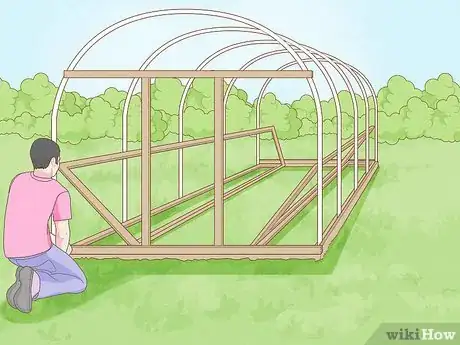

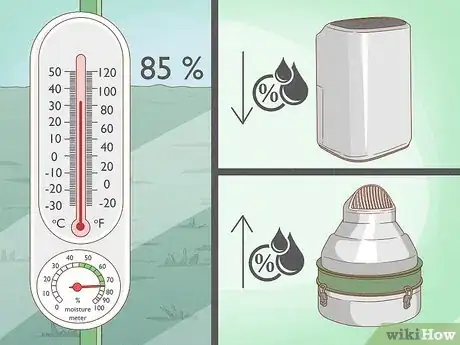
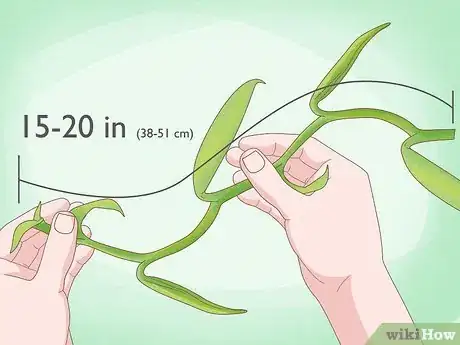
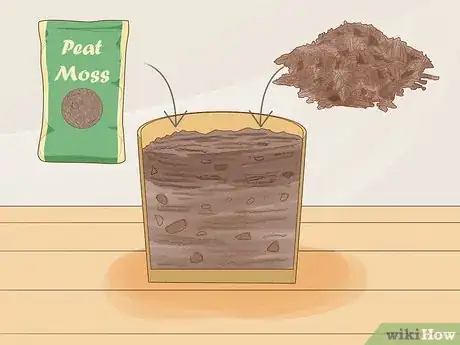

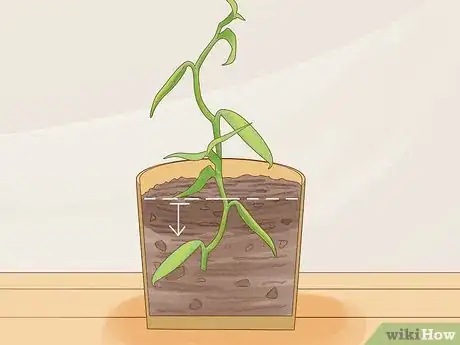
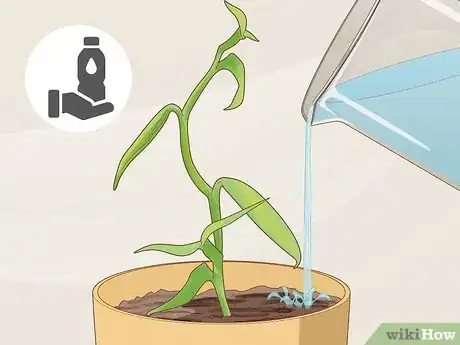
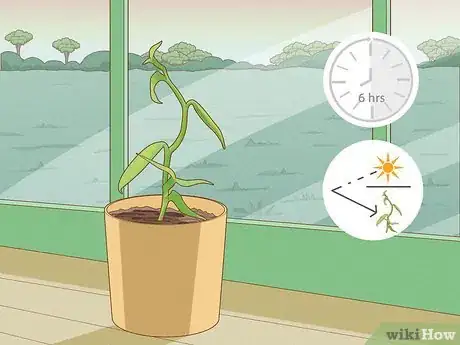
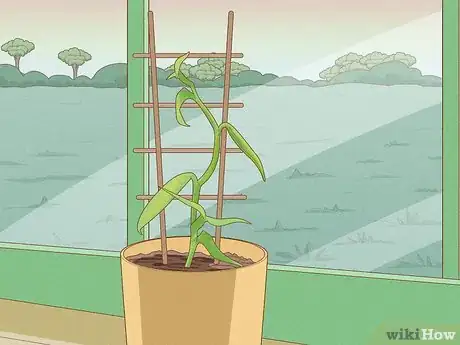
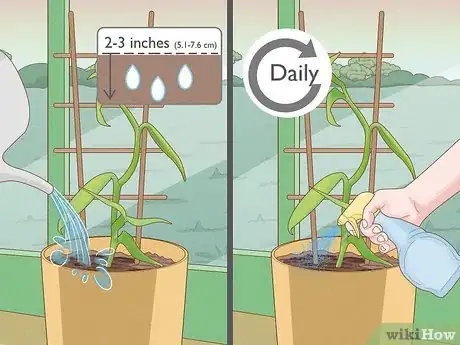
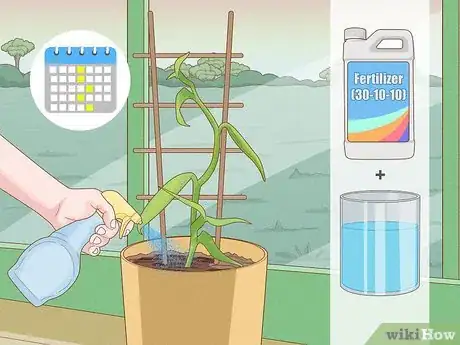
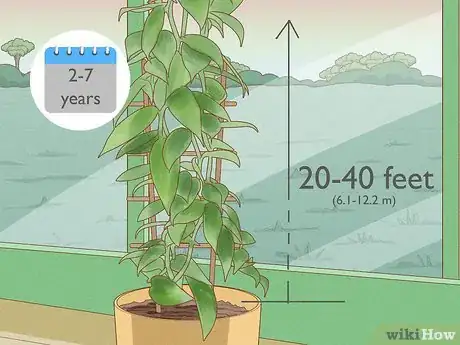
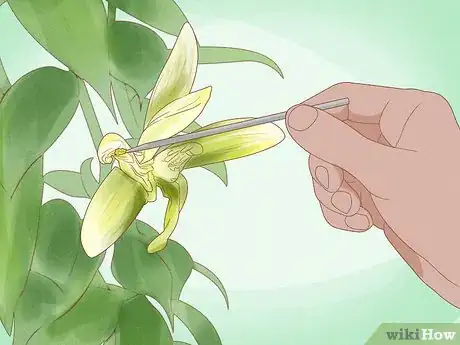
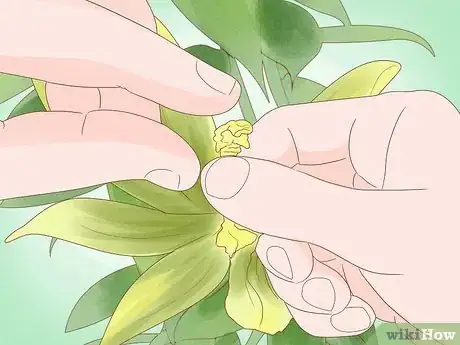
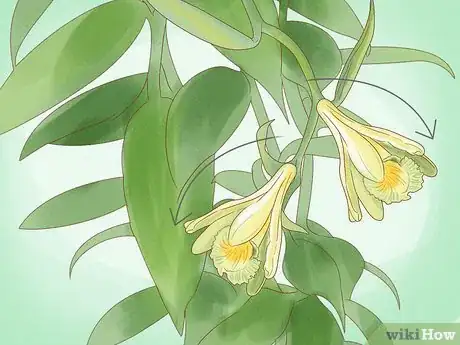

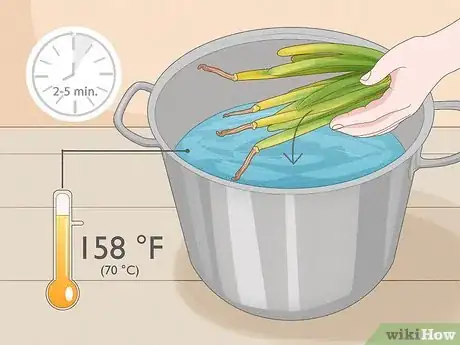

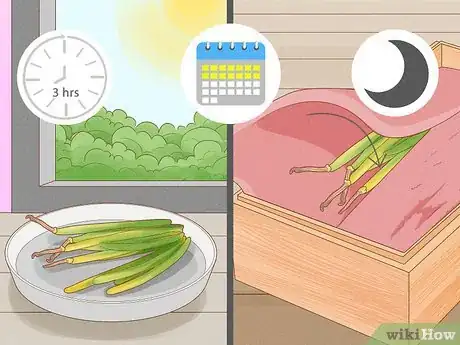
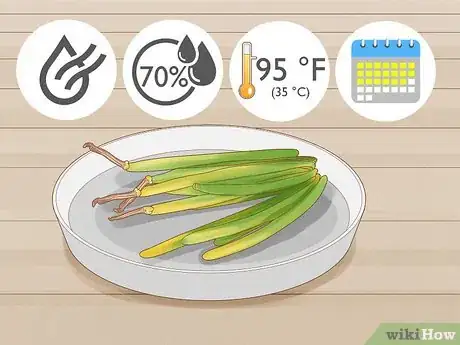

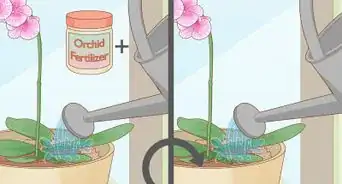

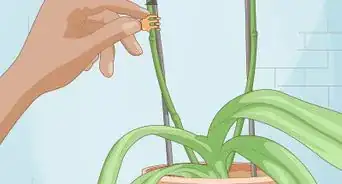
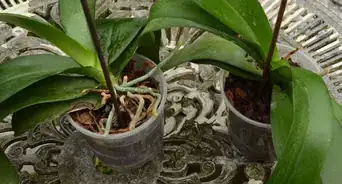

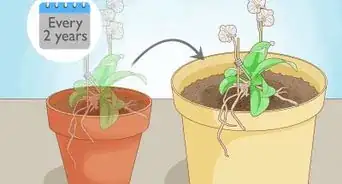

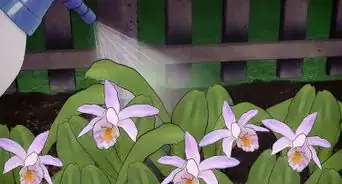
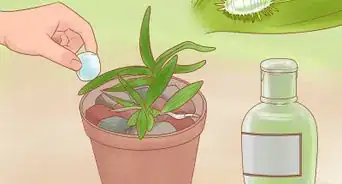
-Step-8.webp)
